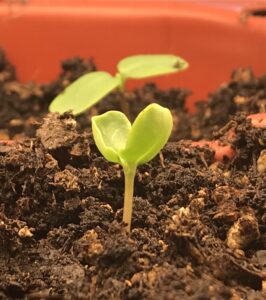5 Tips for First-Time Seed Starters

Are you starting seeds this year, maybe for your first-ever vegetable garden? You might want to check out our free Ready, Set, Grow webinar series on vegetable gardening. Or, consider these five tips for first-time seed starters.
1. Use seed-starting mix. To start seeds indoors, it’s best to use a sterile seed-starting mix. It might be tempting to just dig up some dirt from the garden, but that soil is too prone to compacting and may have diseases or weed seeds that will affect your seedlings. If you have it on hand, potting soil also works. Seed starting mixes have a finer texture than potting soil, but I’ve found both work for starting seeds indoors. If you happen to have coconut coir or peat moss, vermiculite or perlite and some compost, you can even make your own mix. Whatever you use, make sure it is very damp before planting the seeds. (Many nurseries and garden centers are open and doing curbside delivery if you need to buy supplies.)
2. Don’t over spend on equipment. If you are a first-time seed starter, don’t go crazy buying equipment. A simple shoplight with fluorescent bulbs provides as much light as your seedlings need. You can use a variety of recycled or homemade items as containers, including salad containers, yogurt cups or homemade newspaper pots. The container needs to drain, so poke holes in anything plastic. If you can position a fan nearby, that will mimic outdoor conditions and keep your seedlings strong.
3. Put them where you will see them. I used to start seeds in the basement. But when my timer failed and the lights did not go on for days in a row, I moved them upstairs. My seed-starting success skyrocketed. If you see them, you will probably take better care of them, monitoring for water or seeing if seedlings are getting leggy. A more central location may also have natural light, which your seedlings will love. And, your kids will enjoy watching the seedlings grow.

4. Pick easy to start seeds. First-time seed starters will experience more success with seeds that germinate easily. Lettuce, kale, tomatoes and peppers are good vegetables to start with. Annuals such as marigolds or zinnias also grow quickly. Warm-season crops like tomatoes don’t need to be started indoors in Minnesota until mid-April, so you have time.
5. Water judiciously. More plants—houseplants, seedlings, you name it—have been killed by over-watering than under-watering. The soil should be moist after watering but no completely soggy. Let it dry out just a bit between watering. As the seedlings get big for their containers, you will likely have to water more.
To learn more about seed starting, check out our free webinar on April 16. Or, this three part series on seed starting the blog.

2 Comments
-
Pingback: Grow Lettuce Longer: Tips for Extending the Season - Minnesota State Horticultural Society
-
Pingback: WEEKLY MENU 04.23.23 - The Well Seasoned Mom
Back to Blog